Reagent and test cup used for rapid detection of blood viscoelasticity
A viscoelasticity and reagent technology, applied in the field of inspection, can solve the problems of poor repeatability and unevenness of agglutination reaction, and achieve the effects of reducing blood consumption, avoiding test errors and improving stability
- Summary
- Abstract
- Description
- Claims
- Application Information
AI Technical Summary
Problems solved by technology
Method used
Image
Examples
Embodiment 1
[0033] The present embodiment implements a reagent for rapid detection of blood viscoelasticity, which is prepared as follows:
[0034] Add 0.1g NaOH to 1000mL buffer solution (2g MOPS), stir for 10min until the solid dissolves, add 0.1g propyl gallate, and ultrasonicate the mixed solution for 20min to make it fully mixed. Then add 10 g of anhydrous CaCl 2 , 0.01g Tx-100, 0.5g trehalose, 1g glycine, 0.005g BHA and 0.005g sodium azide. Stirring was continued for 30 min until the solid was dissolved, and the pH of the reagent was adjusted to 6.0.
[0035] Then pipette 1uL of the reagent and dispense it on the bottom of the test cup, and place the subpackaged test cup in an oven at 50°C for 30 minutes to dry. The baked test cup is taken out to be a test cup capable of accurately and quickly detecting the viscoelasticity of whole blood.
Embodiment 2
[0037] The present embodiment implements a reagent for rapid detection of blood viscoelasticity, which is prepared as follows:
[0038] Add 0.5g NaOH to 1000mL buffer solution (4g MOPS), stir for 10min until the solid dissolves, add 0.2g propyl gallate, and ultrasonicate the mixed solution for 20min to make it fully mixed. Then add 20 g of anhydrous CaCl 2 , 0.08g Tx-100, 2.5g trehalose, 5g glycine, 0.01g BHA and 0.01g sodium azide. Stirring was continued for 30 min until the solid was dissolved, and the pH of the reagent was adjusted to 7.0.
[0039] Then pipette 5uL of the reagent and dispense it on the bottom of the test cup, and place the subpackaged test cup in an oven at 50°C for 30 minutes to dry. The baked test cup is taken out to be a test cup capable of accurately and quickly detecting the viscoelasticity of whole blood.
Embodiment 3
[0041] The present embodiment implements a reagent for rapid detection of blood viscoelasticity, which is prepared as follows:
[0042] Add 1g NaOH to 1000mL buffer solution (8g MOPS), stir for 10min until the solid dissolves, add 0.5g propyl gallate, and ultrasonicate the mixed solution for 20min to make it fully mixed. Then add 30 g of anhydrous CaCl 2 , 0.1g Tx-100, 5g trehalose, 10g glycine, 0.02g BHA and 0.02g sodium azide. Stirring was continued for 30 min until the solid was dissolved, and the pH of the reagent was adjusted to 9.0.
[0043] Then pipette 20uL of the reagent and dispense it on the bottom of the test cup, and place the subpackaged test cup in an oven at 50°C for 30 minutes to dry. The baked test cup is taken out to be a test cup capable of accurately and quickly detecting the viscoelasticity of whole blood.
[0044] The quality control plasma purchased from Heamoscope was used in the test, and the reference range is shown in the table below:
[0045] ...
PUM
 Login to View More
Login to View More Abstract
Description
Claims
Application Information
 Login to View More
Login to View More - R&D
- Intellectual Property
- Life Sciences
- Materials
- Tech Scout
- Unparalleled Data Quality
- Higher Quality Content
- 60% Fewer Hallucinations
Browse by: Latest US Patents, China's latest patents, Technical Efficacy Thesaurus, Application Domain, Technology Topic, Popular Technical Reports.
© 2025 PatSnap. All rights reserved.Legal|Privacy policy|Modern Slavery Act Transparency Statement|Sitemap|About US| Contact US: help@patsnap.com



